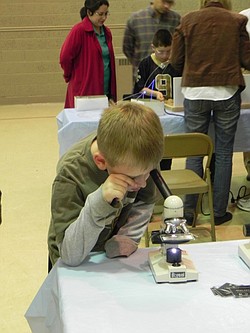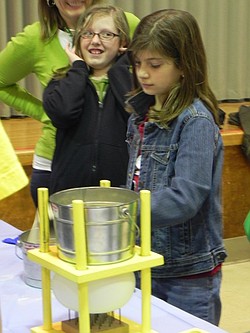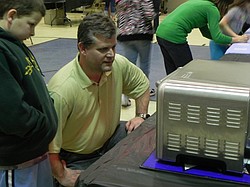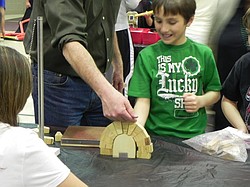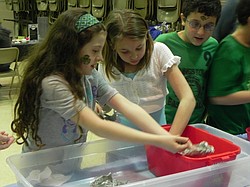Program takes the scary out of science
Neighbors | Sarah Foor.At Union’s Family Physics Night on March 17, Josh Porter did some scientific investigation with a microscope. He explored how the microscope worked at the “Through the Looking Glass” science station.
At the “Pressure Points” experiment station, the students explored how evenly distributing pressure increases the load an object can carry. Students placed a balloon on a bed of nails and found that the balloon wouldn’t pop until 4 pounds of sand became too heavy of a load. Nina Centofanti (right) poured the sand while Audra Lambert prepared for the inevitable “pop.”
Guests were given a parting gift at the Physics Night. The gift, familiar to visitors who grew up in the 1980’s, were colorful Shrinky Dinks, plastic sheets that shrink when heated. Owen Hernon (left) and his dad, Mark, closely watched their gift’s shrinking process in the microwave.
At the “Arches” activity station, Jarret Shurilla attempted to build an arch that would stand freely. During his second try, he was confident that the arch would be successful.
The “Sink or Float” activity station asked the students testing whether certain items fell or floated in water. Gabby Romano (left) and Katie Masucci tried their hand at making an aluminum foil boat to hold marbles. The girls tested how many marbles the boat could hold before falling.
By SARAH FOOR
Beth Colbert, a program presenter for Carnegie Science Center, took the “scary” out of science when she visited Union Elementary on March 17.
“I absolutely think that people are afraid of science concepts,” Colbert said. “Our [Carnegie Science Center] event uses a hands-on approach to make sure that the students are both excited and comfortable with the subject.”
The Pittsburgh-based Carnegie Science Center brought a collection of activity stations that explored different concepts of physics. Poland High School students hosted demonstrations at each table, investigating fiber optics, displacement, pressure, the science of arches, and the uses of glass.
“Physics usually requires one to be a math whiz, but for the young students here, we’ve taken out the math,” explained Colbert of the event’s stations. “Today is more about watching the processes in action and asking questions. Physics is an applied science, and best learned through doing.”
At the science stations, students and parents were free to look through detailed books explaining the processes they had watched. Favorite stations for the guests included testing objects that “sink or float” and an area that offered “Shrinky Dinks” for the guests to take home as a gift.
“Of all the stations, the Shrinky Dinks were my favorite,” said Lisa Shaw, the co-chair of the PTO-sponsored event. “They’re a throwback to my childhood, and the shrinking plastic is an interesting scientific process to watch.”
Although the event provided dazzling displays of science in action, Colbert’s ultimate goal for the event was quite simple.
“If a student learns one new thing that they’ll explore further, our event is a success,” she said.
 43
43

